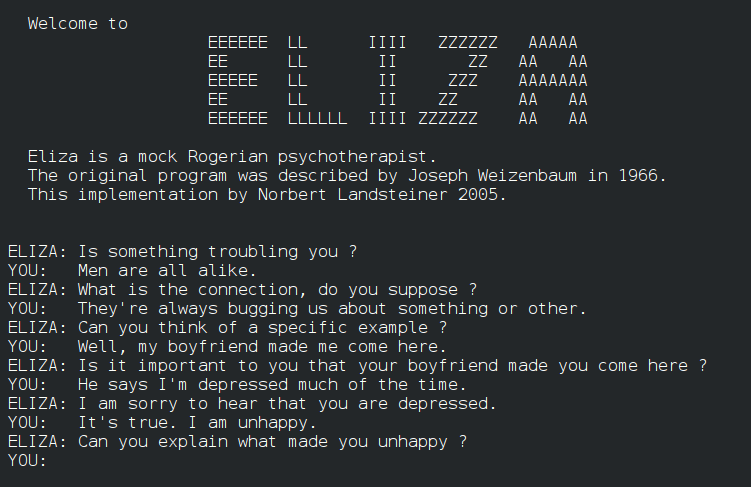
<image a conversation with eliza>
This lecture looks at Artificial Intelligence. We discuss the definition of AI, its history and AI techniques. We explore the philosophy of mind to understand the goal of AI. The development of AI contains many interesting sub-topics. There are many "branches" of AI including: automatic reasoning, formulate AI as search problems, and optimization. The sub-topics become useful tools in their own such as : evolutionary computation, image understanding. The current most popular AI is Generative AI which has strong impact on the future of human labor.
Artificial Intelligence (pptx )
Machine Learning (pptx )
Weak and Strong AI
Philosophy of mind
AI and Logic
ELIZA
Expert system
CYC
Perceptron
Optimization
Natural Language Processing
Computer Vision
===================================================
https://en.wikipedia.org/wiki/Philosophy_of_mind
from Wikipedia
" Philosophy of mind is a branch of philosophy that studies the ontology
and nature of the mind and its relationship with the body. The mind–body
problem is a paradigmatic issue in philosophy of mind, although a number
of other issues are addressed, such as the hard problem of consciousness
and the nature of particular mental states. Aspects of the mind that are
studied include mental events, mental functions, mental properties,
consciousness and its neural correlates, the ontology of the mind, the
nature of cognition and of thought, and the relationship of the mind to
the body."
Can machines think?
https://philpapers.org/browse/can-machines-think
Turing test
Chinese room problem
Cheniese room argument
https://en.wikipedia.org/wiki/Chinese_room
" The Chinese room argument holds that a digital computer executing a
program cannot have a "mind", "understanding", or
"consciousness",regardless of how intelligently or human-like the program
may make the computer behave. The argument was presented by philosopher
John Searle in his paper "Minds, Brains, and Programs", published in
Behavioral and Brain Sciences in 1980. Similar arguments were presented by
Gottfried Leibniz (1714), Anatoly Dneprov (1961), Lawrence Davis (1974)
and Ned Block (1978). Searle's version has been widely discussed in the
years since. The centerpiece of Searle's argument is a thought experiment
known as the Chinese room.
The argument is directed against the philosophical positions of
functionalism and computationalism which hold that the mind may be viewed
as an information-processing system operating on formal symbols, and that
simulation of a given mental state is sufficient for its presence.
Specifically, the argument is intended to refute a position Searle calls
the strong AI hypothesis: "The appropriately programmed computer with the
right inputs and outputs would thereby have a mind in exactly the same
sense human beings have minds."
"
ELIZA
https://en.wikipedia.org/wiki/ELIZA

<image a conversation with eliza>
Rule based
Find out about C
If B, then C (rule 1)
if A, then B (rule 2)
------------
conclusion: If A, then C
Question: Is A true? (data)
MYCIN
https://en.wikipedia.org/wiki/Mycin
Textbook (one chapter)
https://people.dbmi.columbia.edu/~ehs7001/Buchanan-Shortliffe-1984/Chapter-01.pdf
from wikipedia
" MYCIN was an early backward chaining expert system that used artificial
intelligence to identify bacteria causing severe infections, such as
bacteremia and meningitis, and to recommend antibiotics, with the dosage
adjusted for patient's body weight — the name derived from the antibiotics
themselves, as many antibiotics have the suffix "-mycin". The Mycin system
was also used for the diagnosis of blood clotting diseases. MYCIN was
developed over five or six years in the early 1970s at Stanford
University. It was written in Lisp as the doctoral dissertation of Edward
Shortliffe under the direction of Bruce G. Buchanan, Stanley N. Cohen and
others."
EMYCIN
https://link.springer.com/chapter/10.1007/978-3-642-96868-6_66
a book written by Marvin Minsky (one of "the father of AI") "Preceptrons 1969"
https://en.wikipedia.org/wiki/Perceptrons_(book)
Definition
https://en.wikipedia.org/wiki/Perceptron
" In machine learning, the perceptron (or McCulloch-Pitts neuron) is an
algorithm for supervised learning of binary classifiers. A binary
classifier is a function which can decide whether or not an input,
represented by a vector of numbers, belongs to some specific class. It is
a type of linear classifier, i.e. a classification algorithm that makes
its predictions based on a linear predictor function combining a set of
weights with the feature vector. "
https://en.wikipedia.org/wiki/Cyc
" Cyc is a long-term artificial intelligence project that aims to
assemble a comprehensive ontology and knowledge base that spans the basic
concepts and rules about how the world works. Hoping to capture common
sense knowledge, Cyc focuses on implicit knowledge that other AI platforms
may take for granted. This is contrasted with facts one might find
somewhere on the internet or retrieve via a search engine or Wikipedia.
Cyc enables semantic reasoners to perform human-like reasoning and be less
"brittle" when confronted with novel situations.
Douglas Lenat began the project in July 1984 at MCC, where he was
Principal Scientist 1984–1994, and then, since January 1995, has been
under active development by the Cycorp company, where he was the CEO."
simple description
https://techsauce.co/saucy-thoughts/what-is-generative-ai-and-how-it-changing-possibility
https://www.mckinsey.com/featured-insights/mckinsey-explainers/what-is-generative-ai
https://en.wikipedia.org/wiki/Generative_adversarial_network
from Wikipedia
" A generative adversarial network (GAN) is a class of machine learning
framework and a prominent framework for approaching generative AI. The
concept was initially developed by Ian Goodfellow and his colleagues in
June 2014. In a GAN, two neural networks contest with each other in the
form of a zero-sum game, where one agent's gain is another agent's loss.
Given a training set, this technique learns to generate new data with the
same statistics as the training set. For example, a GAN trained on
photographs can generate new photographs that look at least superficially
authentic to human observers, having many realistic characteristics.
Though originally proposed as a form of generative model for unsupervised
learning, GANs have also proved useful for semi-supervised learning, fully
supervised learning, and reinforcement learning. "
Key concept: Generate more data from existing data
contact me at: prabhas dot c at chula dot ac dot th
last update 6 Nov 2023